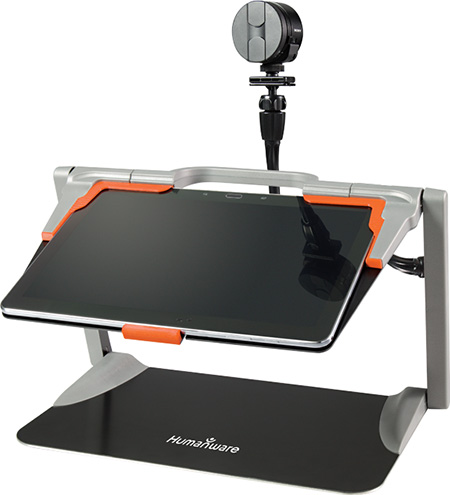In June of 2014 Freedom Scientific released the JAWS Training Bundle, a collection of over 50 hours of JAWS instructional webinars and other learning sessions for Microsoft Windows and Office.
Recently, Freedom Scientific added a second title, the Apple iOS Training Bundle, to its instructional roster. Like its predecessor, the iOS Training Bundle is aimed toward first-time, novice users. Also like its predecessor, it has been produced in DAISY 2.02 audio format with navigational headings and bookmarking capabilities. As we will see, however, this is pretty much where the similarities end.
A Note on Pricing
The iOS Training Bundle costs $599, which to many may seem excessively expensive. Indeed, after its release my Twitter and newslist feeds veritably exploded with messages of outrage about the price. What few mentioned, however, is the fact that the iOS Training Bundle comes preloaded on a Plextalk portable DAISY book player. The player itself retails for $400, although it can be found for as little as $370. This brings the actual content cost down to approximately $230. Freedom Scientific has not made a formal statement about pricing for the bundle without a DAISY player, but they do offer the option to purchase the JAWS Training Bundle without the player, and I can't imagine they would forfeit a sale if asked. The company's reasoning for including the player is that most of their sales will be to new accessibility users, and they want to make the experience as simple as possible. This thinking only goes so far, however, since one of the first accessible devices most newly blind individuals learn to use is an NLS DTB player, which will play the bundle just fine. I think at the very least Freedom Scientific should offer the option to purchase the materials preloaded onto a writeable DTB cartridge.
There are several excellent introductory iOS ePub titles available for considerably less than the Freedom Scientific iOS Training Bundle, but its price does compare favorably to the similar audio tutorial series from Mac for the Blind, which run between $30 and $40 per lesson. Books have their place. Personally, I prefer them to audio tutorials, but for many, especially beginners, an audio tutorial is a better way to learn, since you can follow along and actually hear what the screen reader should be voicing with each command.
What Is Included In the iOS Training Bundle
The iOS Training Bundle consists of approximately ten and a half hours of step-by-step follow-along lessons recorded by Freedom Scientific Director of Blindness Communications and current host of the FSCast podcast, Jonathan Mosen. Mosen is a familiar name within the accessibility community. I first encountered Mosen over the internet in the year 2000 when he founded ACB Radio and hosted the network's premier show: Main Menu. Podcasts didn't exist back then, and for several years I eagerly awaited each new Main Menu episode, which I downloaded from the archives using my blazing fast 56k modem. That way I could listen and re-listen as Mosen introduced me and others to a wide range of accessible software packages, interviewed accessibility mavens, and kept us up on the latest advancements in accessibility. Mosen's teaching style was clear and concise; his production values meticulous.
Happily, Mosen demonstrates these same skills and production values in the iOS Training Bundle. It is an excellent beginners guide, especially for individuals with no previous touch screen experience who—and this does happen all too often—have been handed a new iPhone by his or her rehab agency and told, "We'll send someone out once every other Wednesday for an hour's training session."
Mosen begins from the very beginning, with an iPhone just out of the box with the plastic film on the front glass. After offering a touch tour of the device itself he goes through the setup twice—once for those whose iPhone is set up for them at the store, and a second time for those who need to insert their own SIM and start from scratch. iPad setup is not demonstrated, nor is the iPad even mentioned in the setup section, or much at all elsewhere in the bundle. Granted, the setup process is similar for both devices, minus the SIM card insertion, at least for a Wi-Fi only iPad. But there are definitely times when the screen layout is different, for example, the way Mail displays the message list down one side of the screen and the message content on the other on the iPad. I would not usually quibble about this, but it is called an iOS Training Bundle, after all, not an iPhone Training Bundle.
Mosen does an excellent job demonstrating various touch gestures in a way that someone who has never tried them can easily imitate. He introduces gestures organically, as they are needed to proceed with a lesson, and since this is an audio tutorial the reader is able to follow along and verify he or she is performing each step correctly.
Both virtual and Bluetooth keyboard text entry are covered thoroughly. QuickNav, Keyboard help and other VoiceOver keys are described, but VoiceOver for Mac is not mentioned. It is assumed that the user is running a Windows PC with JAWS for connecting their iPhone to a computer to sync content and make backups. Naturally, Freedom Scientific wants to promote their own products whenever possible, but this is a limitation—connecting to iTunes for the Mac, or to Windows using other screen readers, should at least have been mentioned. That said, Mosen does an excellent job simplifying iTunes, and untangling the web of Apple music services including Apple Music, iCloud Music Library, and iTunes Match.
What Is Missing From the iOS Training Bundle
The Mail, Calendar, and Messages apps are all well covered, as is Siri. Accessibility settings are introduced as they become relevant, but not all are covered. Nothing was said about adding high quality voices to the VO Rotor control, for example, and little to nothing was said about Zoom and other low vision accessibility features. This last is a major omission, in my opinion, and limits the bundle's usefulness significantly for novice iOS users with low vision.
I would not expect any guide for novices to cover every built-in app (for example, Compass, Voice Memos, and Calculator), however there are at least three significant omissions.
- One of the true joys of owning a smartphone is the mapping and GPS navigation features. Apple Maps is not even mentioned in the iOS Training Bundle, much less the ability to create a route and have turn-by-turn directions announced as you travel.
- The iPhone and iPad cameras are extremely useable by the blind, and they can provide a wealth of information to the user. Mosen demonstrates FaceTime in the bundle, but I think a more thorough discussion of how to take photos and videos is warranted. Video playback commands should also have been discussed.
- For novice users who want to learn more, there is a wealth of information to be found through podcasts. Unfortunately, the built-in Podcast app is not mentioned. I would like to have seen a demonstration on how to subscribe to and play a podcast: AppleVis, for example, or even the FSCast.
If you are a current iPhone or iPad user and you have a friend who just obtained their own iOS device, you know that one of their first questions, even before they have mastered basic VoiceOver skills, will be "What apps should I download?" Mosen does show how to download a news app from the iOS App Store, but I think he should have at least mentioned a few of the more essential accessible apps, such as the BARD Mobile app, a currency identifier, and the Be My Eyes remote sighted assistance app. Even a brief mention of these and a few others would have given the user just a tiny taste of what the future holds with continued smartphone use.
And speaking of the future, even though currently only the iPhone 6s and 6s Plus support 3D Touch, all upcoming models will likely include this capability. Mosen only mentions it insofar as to warn users not to press too hard or else they might invoke an unwanted command. I do think a more complete discussion of 3D Touch commands should have been offered.
Final Thoughts
To echo what I wrote when I looked at the JAWS Training Bundle, with the aging population demographics, the number of individuals who could benefit from an accessible smartphone is increasing every year. Qualified trainers are already at a premium, and training budgets strain to keep up. Distance can also be a problem, as many of the newly sight-impaired have yet to develop the mobility skills needed to reach a training center on a regular basis. Others live in rural settings, where one-on-one training is difficult to arrange.
I, like many AccessWorld readers, learned most of what I know about accessible smartphones from podcasts, newslists, and yes, even Apple's sparse documentation. I already had accessible screen reader skills, though. For others, especially those who are newly blind, the iPhone may be their very first experience with accessible computing of any kind. For these individuals the Apple iOS Training Bundle is a good starting point for learning VoiceOver (but not the iOS low vision features). Rehab agencies, Lighthouses for the Blind, and other educational organizations will also benefit from owning a copy or two to loan to their students to reinforce hands-on training sessions.
Comments from Freedom Scientific
Freedom Scientific would like to thank AccessWorld and author Bill Holton for a thoughtful review of the iOS Training Bundle. For customers who already own a hardware DAISY player, please contact our Sales department for an option to purchase the training on SD card only.
Product Information
Product: Apple iOS Training Bundle
Cost: $599 preloaded onto a Plextalk portable DAISY player; availability and pricing have not been announced for the Training Bundle without the player.
Available from: Freedom Scientific, 800-444-4443
Related articles:
- Stream It! Music, Movies, and More with Apple TV and VoiceOver, by Jonathan Mosen: A Book Review by Jamie Pauls
More from this author:
- Workflow: Powerful Automation Made Simple…and iOS Accessible by Bill Holton
- eSight Eyewear and Smart Glasses from Assisted Vision by Bill Holton

